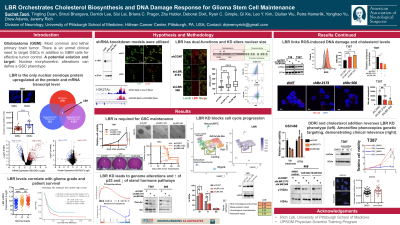LBR Orchestrates Cholesterol Biosynthesis and DNA Damage Response for Glioma Stem Cell Maintenance
Friday, April 21, 2023


Suchet Taori
Medical Student (MS1)
University of Pittsburgh School of Medicine
Pittsburgh, Pennsylvania, United States
ePoster Presenter(s)
Introduction: Glioblastoma (GBM) is the most common and lethal primary brain tumor. Poor prognosis is associated with GBM heterogeneity and glioma stem cell (GSC) presence. GSCs can promote GBM progression via distinct metabolic, transcriptional, and epigenetic profiles that contribute to invasion, self-renewal, and treatment resistance. Nuclear morphometric alterations have been correlated with these specific cellular states and varied cancer pathologies; however, underlying mechanisms are poorly understood in GBM.
Methods: RNA-Seq and comparative mass spectrometry analysis of matched GSCs and differentiated glioma cells (DGCs) revealed that the Lamin B receptor (LBR) is a highly upregulated nuclear envelope protein in GSCs with known, seemingly separate, functions in chromatin organization and cholesterol biosynthesis. Bioinformatic analysis suggested LBR levels correlated with glioma histology, grade, and survival in patient samples. shRNAs targeting LBR were utilized as a knockdown model.
Results: LBR is preferentially expressed in GSCs, and LBR knockdown led to alterations in nuclear size, reduced viability and self-renewing capacity, and cell cycle blockage in GSCs but not DGCs. Bioinformatic analysis and in-vitro testing indicated LBR loss in GSCs concurrently altered the chromatin state and decreased nuclear lipid droplet formation, uniquely linking LBR’s functions in lipid biosynthesis and genomic re-organization. LBR and lipid droplet loss increased reactive oxygen species production, resulting in increased DNA damage; inhibiting DNA damage repair proteins rescued defects in LBR knockdown GSCs. In radiation models, LBR was required for DNA damage repair and LBR knockdown synergized with radiation to reduce viability. Lastly, LBR knockdown reduced tumor burden and improved mice survival in-vivo. Pharmacologically inhibiting LBR’s sterol reductase activity in GSCs phenocopied genetic targeting, relinking LBR’s dual-functions, and demonstrating clinical significance.
Conclusion : LBR is required for GSC maintenance by mediating a cross-talk between cholesterol biosynthesis and chromatin organization; targeting LBR constitutes a promising therapeutic intervention for GBM. Future studies will elucidate LBR’s structure-function relationship.
Methods: RNA-Seq and comparative mass spectrometry analysis of matched GSCs and differentiated glioma cells (DGCs) revealed that the Lamin B receptor (LBR) is a highly upregulated nuclear envelope protein in GSCs with known, seemingly separate, functions in chromatin organization and cholesterol biosynthesis. Bioinformatic analysis suggested LBR levels correlated with glioma histology, grade, and survival in patient samples. shRNAs targeting LBR were utilized as a knockdown model.
Results: LBR is preferentially expressed in GSCs, and LBR knockdown led to alterations in nuclear size, reduced viability and self-renewing capacity, and cell cycle blockage in GSCs but not DGCs. Bioinformatic analysis and in-vitro testing indicated LBR loss in GSCs concurrently altered the chromatin state and decreased nuclear lipid droplet formation, uniquely linking LBR’s functions in lipid biosynthesis and genomic re-organization. LBR and lipid droplet loss increased reactive oxygen species production, resulting in increased DNA damage; inhibiting DNA damage repair proteins rescued defects in LBR knockdown GSCs. In radiation models, LBR was required for DNA damage repair and LBR knockdown synergized with radiation to reduce viability. Lastly, LBR knockdown reduced tumor burden and improved mice survival in-vivo. Pharmacologically inhibiting LBR’s sterol reductase activity in GSCs phenocopied genetic targeting, relinking LBR’s dual-functions, and demonstrating clinical significance.
Conclusion : LBR is required for GSC maintenance by mediating a cross-talk between cholesterol biosynthesis and chromatin organization; targeting LBR constitutes a promising therapeutic intervention for GBM. Future studies will elucidate LBR’s structure-function relationship.
